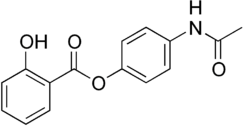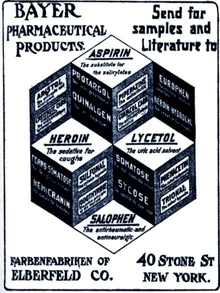Acetaminosalol
Acetaminosalol is an organic compound with the chemical formula C15H13NO4.
 | |
| Names | |
|---|---|
| Preferred IUPAC name
4-Acetamidophenyl 2-hydroxybenzoate | |
| Identifiers | |
3D model (JSmol) |
|
| ChEBI | |
| ChEMBL | |
| ChemSpider | |
| ECHA InfoCard | 100.003.875 |
| EC Number |
|
| MeSH | Salophen |
PubChem CID |
|
| UNII | |
CompTox Dashboard (EPA) |
|
| |
| |
| Properties | |
| C15H13NO4 | |
| Molar mass | 271.272 g·mol−1 |
| Density | 1.327 g cm−3 |
| log P | 2.562 |
| Acidity (pKa) | 7.874 |
| Basicity (pKb) | 6.123 |
| Hazards | |
| Flash point | 241.9 °C (467.4 °F; 515.0 K) |
Except where otherwise noted, data are given for materials in their standard state (at 25 °C [77 °F], 100 kPa). | |
| Infobox references | |
It is an esterfication product of salicylic acid and paracetamol. It was marketed by Bayer under the brand name Salophen as an analgesic in the late 19th and early 20th centuries.
Action and uses
In a warm alkaline solution acetaminosalol is broken up into salicylic acid and paracetamol. It is decomposed in the intestines, even when given as an injection. It was used as a substitute for salicylic acid in acute rheumatism, and as an intestinal antiseptic. It was similarly effective and much safer than salol, another intestinal antiseptic commonly used at the time. The fact that it is tasteless renders it easy to administer.

Advertisement for early 20th century Bayer products, including Salophen
gollark: Yes, that seems reasonable, but would be fiddly to implement.
gollark: Can you give it to me? I need it for, er, sliced bread.
gollark: Visit Chorus City, because *its* street signs are *not* down.
gollark: You had a stupid amount of carts within an hour?
gollark: Doubleplusunbrain.
References
This article is issued from Wikipedia. The text is licensed under Creative Commons - Attribution - Sharealike. Additional terms may apply for the media files.